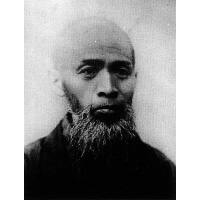Column: Patent System in the Meiji Period
Exhibited at the first National Industrial Exhibition was a Japanese-style cotton spinning machine, called a gara-bo in Japanese, by Tatchi Gaun (1842-1900). This machine was appraised as the best invention displayed at the event. However, since the machine featured a simple mechanism, many imitations were manufactured. This placed him in a great financial difficulty (although Gaun exhibited an improved version of the gara-bo at the second National Industrial Exhibition despite such a severe situation, and won the Shinpo-nito-sho [improvement second prize]). Subsequently, a lack of investment money prevented him from making inventions in his hometown, forcing him move to Tokyo, where he received support from Ichu Omori, a judge of the National Industrial Exhibition.
What forced Tatchi Gaun into the predicament despite his great honor was the lack of a system to protect inventors in Japan as of 1877. Certainly, the Japanese patent system had already begun with the promulgation of the Senbai ryaku kisoku, (monopoly summary rules) in 1871. However, the rules were suspended in the following year, with consideration given to the reality of the people's lives still influenced by the feudal system, the management of the patent system by the authorities concerned, and the insistence in foreign countries that a patent system was unnecessary (and that such a system would prevent the development of technologies).

Tatchi Gaun in His Late Years (Miyashita, Kazuo.: 【Gaun Tatchi】. Kyodo shuppansha, 1993)
Subsequently, Japanese people became more aware of Western countries, drawing public attention to inventions. At the international conference held at the Vienna International Exposition of 1873, the effectiveness of a patent system was confirmed. Moreover, some Japanese people believed that a patent system was necessary not only as a reward for an inventor, but also as a protection of Japanese industries from foreign counterparts in the context of the actual conditions of overseas trade. With this as a background, Korekiyo Takahashi attached to the Komu Kyoku (Bureau of Industry) of the Noshomu-sho (Ministry of Agriculture and Commerce) was committed to the promulgation and enforcement of the Senbai-tokkyo-jorei (monopoly patent ordinance) in 1885, which was followed by the establishment of subsequent patent-related rules. Since Japan was still at the stage of absorbing overseas technologies, the country did not accept patent applications by foreign persons. In 1899, however, while promoting diplomatic negotiations regarding the revision of its unequal treaty with foreign countries, Japan participated in the Paris Convention for the Protection of Industrial Property.
In 1882, Tatchi Gaun was granted the Medal with Blue Ribbon in recognition of his excellent achievements. After he produced another invention, his life became financially easier. He passed away in 1900.
→ For the international patent system, see the Column: International Patent System
- References:
-
Ichikawa, Kazuo.: Nihon no tokkyo seido -4- in Patento v. 16 n. 10 (1963.10) <Z14-185>
Ichikawa, Kazuo.: Nihon no tokkyo seido -6- in Patento v. 16 n. 12 (1963.12) <Z14-185>
Koga, Kikushi.: Nihon tokkyo seido no rekishiteki gaikan in Patento v. 16 n. 10 (1963.10) <Z14-185>)
Nakayama, Shigeru.: Hakurankai to tokkyo in Yoshida, Mitsukuni (ed).: Bankoku hakurankai no kenkyu (Shibunkaku shuppan, 1986) <D7-71>)
Nihon no 'sozoryoku' : Kindai gendai o kaika saseta 470 nin. n. 4 (Nihon hoso shuppan kyokai, 1993) <GK13-E574>

